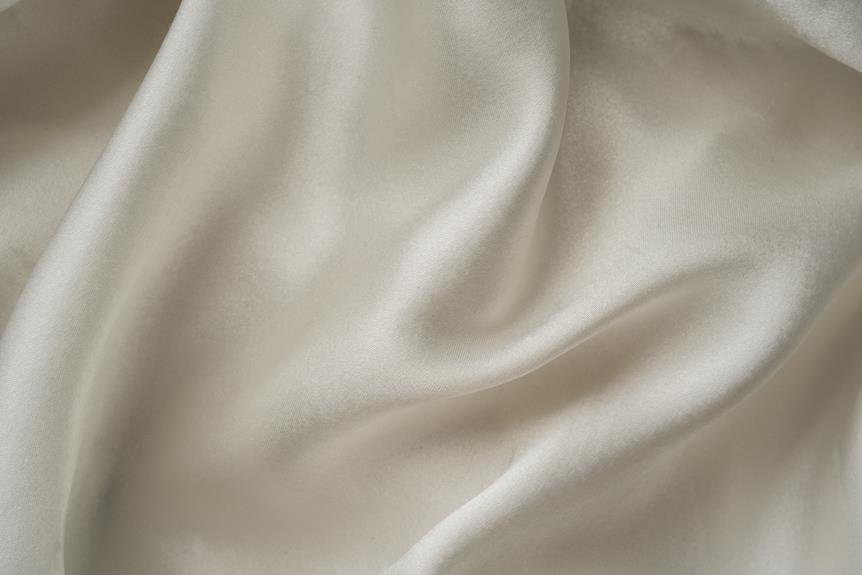Curious about the intricacies of silk chiffon? Wondering how to master this delicate fabric? Silk chiffon: What You Need to Know provides essential insights for your journey to expertise.
Delve into the origins, characteristics, and styling possibilities of silk chiffon. Explore its pros and cons, and gain valuable tips for working with this luxurious material.
Whether you're a seasoned designer or an aspiring enthusiast, this guide equips you with the knowledge to elevate your creations.
Key Takeaways
- Silk chiffon is a delicate and lightweight fabric known for its beautiful drape effect.
- It is breathable and perfect for warm weather clothing.
- Silk chiffon requires extra care and maintenance due to its tendency to wrinkle.
- When working with silk chiffon, it is important to use sharp needles, handle the fabric gently, and test the appropriate heat setting before ironing.
The Origins of Silk Chiffon
Understanding the origins of silk chiffon involves exploring its rich history and cultural significance. Silk chiffon has a fascinating origin story that dates back to ancient China, where the luxurious fabric was first created. The production of silk chiffon is an intricate process that requires skilled artisans and meticulous attention to detail. The delicate and sheer nature of chiffon sets it apart from other silk fabrics, making it a popular choice for elegant and flowy garments.
Silk chiffon originates from the silk-producing regions of China, where the production techniques have been honed and perfected over centuries. The fabric is made from the natural protein fibers produced by silkworms, which are carefully unraveled to create fine, lightweight threads. These threads are then woven into a sheer, gossamer-like fabric that's renowned for its softness and drape. The production techniques for silk chiffon involve careful handling of the delicate silk threads, as well as specialized weaving methods to create the fabric's signature airy texture.
The intricate process of producing silk chiffon results in a fabric that's highly sought after for its luxurious feel and elegant appearance. Understanding the origins and production techniques of silk chiffon sheds light on the craftsmanship and artistry behind this timeless textile.
Characteristics and Properties
When working with silk chiffon, you'll notice its ethereal and delicate nature, perfect for creating elegant and flowing garments. Silk chiffon possesses several distinct characteristics and properties that make it a favorite among designers and fashion enthusiasts. Here are some key points to keep in mind:
- Sheerness: Silk chiffon is renowned for its sheer quality, adding a sense of allure and sophistication to any garment.
- Drape Effect: Due to its lightweight and airy nature, silk chiffon has a beautiful drape effect, making it ideal for creating fluid and graceful silhouettes.
- Layering Technique: Its translucency makes silk chiffon a popular choice for layering in garments, allowing for subtle glimpses of underlying layers and creating depth in the overall look.
- Soft Texture: The fabric has a soft and luxurious texture that feels delightful against the skin, adding to the comfort and elegance of the garment.
Understanding these characteristics and properties of silk chiffon can help you make informed decisions when incorporating this exquisite fabric into your designs. Whether you're aiming for a romantic, ethereal look or seeking to add a touch of sophistication to your creations, silk chiffon offers a world of possibilities.
Pros and Cons of Silk Chiffon
Silk chiffon offers a luxurious, airy texture that drapes beautifully and feels delicate against the skin.
However, it's important to note that this fabric is prone to wrinkles, so it may require extra care and maintenance to keep it looking its best.
As you explore the pros and cons of silk chiffon, consider these factors to determine if it aligns with your preferences and lifestyle.
Airy and Delicate Texture
With silk chiffon, you'll experience the luxurious sensation of airy lightness and delicate texture against your skin. This fabric offers a unique combination of elegance and versatility, making it a popular choice for various fashion applications.
Here are some key points to consider when it comes to the airy and delicate texture of silk chiffon:
- Lightweight: Silk chiffon is incredibly lightweight, allowing for graceful and flowing garments that drape beautifully.
- Breathability: The airy nature of silk chiffon provides excellent breathability, making it an ideal choice for warm weather clothing.
- Delicate: The delicate texture of silk chiffon adds a touch of sophistication to any outfit, creating a sense of ethereal beauty.
- Layering: Its sheer quality makes silk chiffon perfect for layering, adding dimension and elegance to any ensemble.
Silk chiffon's airy and delicate texture offers a sense of luxury and refinement, making it a sought-after fabric for those who appreciate timeless elegance.
Prone to Wrinkles
If you're considering silk chiffon for your wardrobe, it's important to be aware that this fabric is prone to wrinkles. While the delicate and airy texture of silk chiffon gives it an elegant and luxurious appeal, it also means that it tends to wrinkle easily.
This characteristic can be both a pro and a con. On the one hand, the natural wrinkling adds a romantic and effortless charm to the fabric, enhancing its ethereal beauty. On the other hand, it requires extra care and attention when it comes to fabric care.
When ironing silk chiffon, use a low-heat setting and a pressing cloth to protect the fabric. Always iron on the reverse side to prevent damage. Hanging silk chiffon items in the bathroom while showering can also help release wrinkles without direct ironing.
Tips for Working With Silk Chiffon
When working with silk chiffon, always handle it gently to avoid tearing or snagging the delicate fabric. Silk chiffon requires special care and attention due to its lightweight and delicate nature.
Here are some essential tips for working with silk chiffon:
- Use sharp, fine needles: When sewing with silk chiffon, opt for a small, sharp needle to prevent pulling or stretching the fabric. A fine needle will create smaller holes, minimizing the risk of tears.
- Pin carefully: When pinning the fabric, place the pins within the seam allowance to avoid leaving visible holes or marks on the finished garment. Consider using silk pins or clips to secure the fabric without causing damage.
- Employ a rotary cutter: When cutting silk chiffon, a rotary cutter can be more effective than scissors as it reduces the risk of shifting and distorting the fabric, resulting in cleaner, more precise cuts.
- Test before pressing: Before ironing silk chiffon, test a scrap piece of fabric to determine the appropriate heat setting. Always use a pressing cloth to protect the delicate fabric from direct heat and potential damage.
Care and Maintenance Guidelines
To keep your silk chiffon garments in pristine condition, it's essential to follow specific care and maintenance guidelines. When it comes to washing techniques, silk chiffon should be hand-washed in cold water using a gentle detergent. Avoid wringing or twisting the fabric, as this can cause damage. Instead, gently press the water out and lay the garment flat on a towel to dry. Ironing silk chiffon should be done on a low heat setting with a pressing cloth to protect the delicate fabric.
In terms of storage solutions, silk chiffon should be hung or folded with care. Hanging silk chiffon garments can help prevent wrinkles, but be sure to use padded or rounded hangers to avoid stretching or distorting the fabric. If folding, use acid-free tissue paper to cushion the folds and store the garment in a breathable garment bag to protect it from dust and light.
Styling and Design Inspiration
When styling silk chiffon garments, focus on creating elegant and timeless looks that showcase the fabric's delicate beauty and ethereal drape. To achieve this, consider the following tips:
- Fashion Trends: Stay updated on current fashion trends to incorporate modern elements into your silk chiffon ensembles. Look for inspiration from fashion magazines, runway shows, and celebrity red carpet looks to infuse contemporary style into your outfits.
- Color Combinations: Experiment with sophisticated color combinations to complement the ethereal nature of silk chiffon. Opt for classic pairings like soft pastels with neutrals for a romantic and graceful aesthetic. Alternatively, consider bold and contrasting hues for a modern and vibrant look.
- Celebrity Red Carpet: Draw inspiration from celebrity red carpet looks that feature silk chiffon dresses or gowns. Pay attention to how celebrities style and accessorize their outfits to create stunning and polished ensembles.
- Runway Looks: Keep an eye on runway collections to gather innovative ideas for styling silk chiffon pieces. Runway looks often showcase inventive ways to incorporate silk chiffon into high-fashion ensembles, providing inspiration for unique and fashion-forward styling.
Frequently Asked Questions
Can Silk Chiffon Be Dyed at Home?
Yes, you can DIY dye silk chiffon at home. However, ensure the dye is suitable for silk and follow the instructions carefully for best results. Test for color fastness before dyeing the entire fabric to avoid disappointment.
Is Silk Chiffon Suitable for Everyday Wear or Is It More of a Special Occasion Fabric?
Silk chiffon is best suited for special occasions due to its delicate nature. However, it can be worn for everyday wear with care. While dyeing at home is possible, following care instructions is crucial. Additionally, it's not suitable for upholstery or home decor projects.
What Are Some Common Mistakes People Make When Working With Silk Chiffon?
To avoid fraying, choose the right needle when working with silk chiffon. Using a fine, sharp needle can help prevent snags and runs in the delicate fabric. Be mindful of tension and handling to avoid mishaps.
Are There Any Specific Care Instructions for Silk Chiffon in Different Climates or Weather Conditions?
In humid climates, silk chiffon needs gentle care to prevent mold. In cold weather, avoid exposing it to extreme temperatures. Store in a cool, dry place. In hot weather, handle with care to prevent damage from heat and sun exposure.
Can Silk Chiffon Be Used for Upholstery or Home Decor Projects?
Yes, silk chiffon can be used for upholstery and home decor projects. Its lightweight and sheer nature lends a delicate and elegant touch to interior design. However, it may not be as durable as other fabric choices.
- Tetron Fabric for Marine Applications: Durability and Use Cases - June 18, 2025
- Tetron Fabric for Outdoor Furniture: Weather Resistance and Care - June 18, 2025
- Tetron Fabric for Wall Coverings: Style and Application Tips - June 18, 2025



